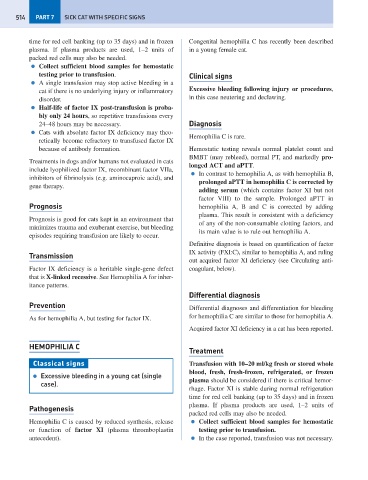Page 522 - Problem-Based Feline Medicine
P. 522
514 PART 7 SICK CAT WITH SPECIFIC SIGNS
time for red cell banking (up to 35 days) and in frozen Congenital hemophilia C has recently been described
plasma. If plasma products are used, 1–2 units of in a young female cat.
packed red cells may also be needed.
● Collect sufficient blood samples for hemostatic
testing prior to transfusion. Clinical signs
● A single transfusion may stop active bleeding in a
cat if there is no underlying injury or inflammatory Excessive bleeding following injury or procedures,
disorder. in this case neutering and declawing.
● Half-life of factor IX post-transfusion is proba-
bly only 24 hours, so repetitive transfusions every
24–48 hours may be necessary. Diagnosis
● Cats with absolute factor IX deficiency may theo-
Hemophilia C is rare.
retically become refractory to transfused factor IX
because of antibody formation. Hemostatic testing reveals normal platelet count and
BMBT (may rebleed), normal PT, and markedly pro-
Treatments in dogs and/or humans not evaluated in cats
longed ACT and aPTT.
include lyophilized factor IX, recombinant factor VIIa,
● In contrast to hemophilia A, as with hemophilia B,
inhibitors of fibrinolysis (e.g. aminocaproic acid), and
prolonged aPTT in hemophilia C is corrected by
gene therapy.
adding serum (which contains factor XI but not
factor VIII) to the sample. Prolonged aPTT in
Prognosis hemophilia A, B and C is corrected by adding
plasma. This result is consistent with a deficiency
Prognosis is good for cats kept in an environment that
of any of the non-consumable clotting factors, and
minimizes trauma and exuberant exercise, but bleeding
its main value is to rule out hemophilia A.
episodes requiring transfusion are likely to occur.
Definitive diagnosis is based on quantification of factor
IX activity (FXI:C), similar to hemophilia A, and ruling
Transmission
out acquired factor XI deficiency (see Circulating anti-
Factor IX deficiency is a heritable single-gene defect coagulant, below).
that is X-linked recessive. See Hemophilia A for inher-
itance patterns.
Differential diagnosis
Prevention Differential diagnoses and differentiation for bleeding
As for hemophilia A, but testing for factor IX. for hemophilia C are similar to those for hemophilia A.
Acquired factor XI deficiency in a cat has been reported.
HEMOPHILIA C
Treatment
Classical signs Transfusion with 10–20 ml/kg fresh or stored whole
blood, fresh, fresh-frozen, refrigerated, or frozen
● Excessive bleeding in a young cat (single
plasma should be considered if there is critical hemor-
case).
rhage. Factor XI is stable during normal refrigeration
time for red cell banking (up to 35 days) and in frozen
plasma. If plasma products are used, 1–2 units of
Pathogenesis
packed red cells may also be needed.
Hemophilia C is caused by reduced synthesis, release ● Collect sufficient blood samples for hemostatic
or function of factor XI (plasma thromboplastin testing prior to transfusion.
antecedent). ● In the case reported, transfusion was not necessary.

